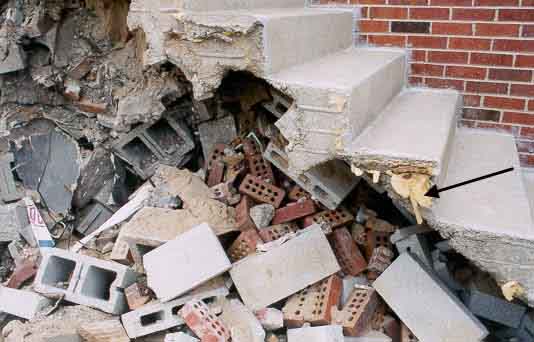CONCRETE AND MASONRY WALL FAILURE ANALYSIS (PART 2)
By
Charles C. Roberts, Jr., Ph. D., P.E.
If one's endeavor in life is to investigate masonry wall failures, a long and
fruitful career can be expected. Figure 1 is a view of a collapsed stairway
masonry wall that was less than 2 years old. The outer wall of a stairway
collapsed outward onto the sidewalk and lawn area of a new condominium
complex.

Figure 1
According to witnesses, the structure collapsed with a loud "boom." Luckily,
no one was injured as a result of the failure. Figure 2 is a closer view of the
masonry near the stairs, revealing intriguing detail of the inner structure of
the wall system. The center arrow points to concrete blocks that have been
trapped by mortar in random orientations, unlike a properly built masonry
structure where masonry units are systematically laid. This suggests that after
the brick wall had been constructed, and before the stairs were

Figure 2
poured, concrete blocks, bricks, construction debris and sand were dumped
into the cavity to act as fill to support the concrete stairs. The outline of the
brick joints, as indicated by the top arrow, is evidence that the brick wall was
in place when the stairs were poured and that the concrete blocks were simply
dumped into the cavity. With no anchors to the neighboring wall, the
stairway structure was doomed to failure over time, due to settling and
moisture related influences such as rain and ice. What happens is that the
wall slowly pushes outward as a result of the settling construction debris. In
Figure 2, the left arrow shows additional mortar placed at the stair/wall
interface to seal the gap forming as the wall moved outward. Apparently,
there was ample warning of the wall deflection outward. Adding mortar to
the developing crack was chosen as a way to repair the structure.

Figure 3
In Figure 3, the arrow points to foam sealant injected to seal the large crack
forming as the wall moved outward. Figure 3 also shows additional debris
such as concrete rubble, sheet rock and packaging materials. It is reasonable
to conclude that the contractor decided to used the stair cavity behind the wall
as a convenient garbage dump for construction materials. The contractor
might have succeeded in his deceptively fine masonry job, if appropriate
structural anchoring of the outer wall to the building wall had been employed.
Inevitably, the laws of physics prevailed, laying out to the world, a masonry
structure that was deficient in concept and in construction.
For those interested in Concrete and Masonry Wall Failure Analysis (Part 1),
see Claims Magazine (April 1992) or Claims Magazine Technical Notebook.
FOR TECHNICAL ARTICLES CONTACT CLAIMS MAGAZINE AND ASK
FOR A REPRINT OF A PAST TECHNICAL NOTEBOOK ARTICLE
CLAIMS MAGAZINE



